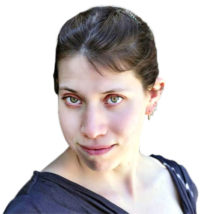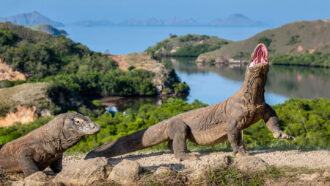

A molecule is usually two or more atoms held together with chemical bonds.
Molecules can be homonuclear. That means they contain atoms of only one element. The oxygen we breathe, for example, is a molecule of two oxygen atoms — O2. Other molecules are heteronuclear — made of more than one element. A molecule of water — H2O — is made of two hydrogen atoms bonded to one oxygen atom.
Molecules make up your own body, the air we breathe, everything living around us. A molecule is the smallest particle of a substance that still has all the chemical properties of that substance. For example, a single molecule of water — H2O — has all the properties of water. But split it apart into its atoms, and it will not be water anymore.
Smaller molecules can join together to make up large ones. A single strand of DNA, for instance, is one large molecule. That one molecule of DNA is made from many smaller molecules, including sugars and phosphates. Take apart a DNA molecule and it will not be able to do what DNA does — provide the instructions cells need to survive.
Put together, the atoms in most molecules have a neutral electrical charge — neither positive nor negative. But some atoms — such as helium — don’t have any electrical charge, even by themselves. Some people count these single atoms as molecules too. And some molecules do have an electrical charge. These charged molecules are called ions.
In your armpits, bacteria turn an odorless molecule in our sweat into one that truly stinks.

Weekly updates to help you use Science News Explores in the learning environment
Thank you for signing up!
There was a problem signing you up.
atmosphere: The envelope of gases surrounding Earth or another planet.
atom: The basic unit of a chemical element. Atoms are made up of a dense nucleus that contains positively charged protons and uncharged neutrons. The nucleus is orbited by a cloud of negatively charged electrons.
bacteria: (singular: bacterium) Single-celled organisms. These dwell nearly everywhere on Earth, from the bottom of the sea to inside other living organisms (such as plants and animals). Bacteria are one of the three domains of life on Earth.
bond: (in chemistry) A semi-permanent attachment between atoms — or groups of atoms — in a molecule. It’s formed by an attractive force between the participating atoms. Once bonded, the atoms will work as a unit. To separate the component atoms, energy must be supplied to the molecule as heat or some other type of radiation.
cell: The smallest structural and functional unit of an organism. Typically too small to see with the unaided eye, it consists of a watery fluid surrounded by a membrane or wall. Depending on their size, animals are made of anywhere from thousands to trillions of cells. Most organisms, such as yeasts, molds, bacteria and some algae, are composed of only one cell.
DNA: (short for deoxyribonucleic acid) A long, double-stranded and spiral-shaped molecule inside most living cells that carries genetic instructions. It is built on a backbone of phosphorus, oxygen, and carbon atoms. In all living things, from plants and animals to microbes, these instructions tell cells which molecules to make.
element: A building block of some larger structure. (in chemistry) Each of more than one hundred substances for which the smallest unit of each is a single atom. Examples include hydrogen, oxygen, carbon, lithium and uranium.
helium: An inert gas that is the lightest member of the noble gas series. Helium can become a solid at -272 degrees Celsius (-458 degrees Fahrenheit).
heteronuclear: A molecule made of more than one chemical element.
homonuclear: A molecule made of only one kind of chemical element.
hydrogen: The lightest element in the universe. As a gas, it is colorless, odorless and highly flammable. It’s an integral part of many fuels, fats and chemicals that make up living tissues. It’s made of a single proton (which serves as its nucleus) orbited by a single electron.
ion: (adj. ionized) An atom or molecule with an electric charge due to the loss or gain of one or more electrons. An ionized gas, or plasma, is where all of the electrons have been separated from their parent atoms.
molecule: An electrically neutral group of atoms that represents the smallest possible amount of a chemical compound. Molecules can be made of single types of atoms or of different types. For example, the oxygen in the air is made of two oxygen atoms (O2), but water is made of two hydrogen atoms and one oxygen atom (H2O).
oxygen: A gas that makes up about 21 percent of Earth's atmosphere. All animals and many microorganisms need oxygen to fuel their growth (and metabolism).
particle: A minute amount of something.

Bethany Brookshire was a longtime staff writer at Science News Explores and is the author of the book Pests: How Humans Create Animal Villains. She has a Ph.D. in physiology and pharmacology and likes to write about neuroscience, biology, climate and more. She thinks Porgs are an invasive species.
Free educator resources are available for this article. Register to access:
Already Registered? Enter your e-mail address above.
Readability Score: 7.6



 raised and mouth open." width="330" height="186" />
raised and mouth open." width="330" height="186" /> element 120 shows 120 electrons arranged around a nucleus." width="330" height="186" />
element 120 shows 120 electrons arranged around a nucleus." width="330" height="186" />





Founded in 2003, Science News Explores is a free, award-winning online publication dedicated to providing age-appropriate science news to learners, parents and educators. The publication, as well as Science News magazine, are published by the Society for Science, a nonprofit 501(c)(3) membership organization dedicated to public engagement in scientific research and education.
© Society for Science & the Public 2000–2024. All rights reserved.